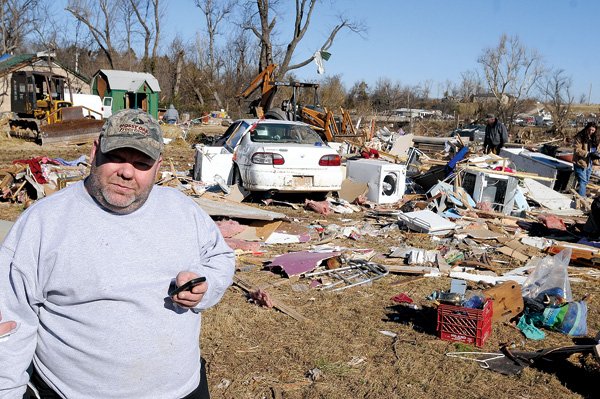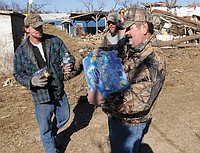CINCINNATI — In Washington County, the storm left three dead and eight injured, in addition to destroying 29 homes and six business, said Tommy Jackson, Arkansas Department of Emergency Management spokesman. In Benton County, 13 homes and five businesses were destroyed, he said.
Killed in the storm were James Richard “Dick” Murray, 78, Gerald Dean “Buck” Wilson, 88, and his wife, Mamie Wilson, 78, officials said. Wilson was Grubbs’ grandmother.
Reality set in Saturday, Grubbs said, as he began to process the previous day’s events. He took a cigarette break while friends and family picked through the shredded remains of his house. Twisted sheet metal covered a tree behind him, like other trees in the area. Grubbs said he hoped to recover his clothes, photographs, CDs and video games.
“I’m tired,” he said. “Everything else, I’ll just let them plow it over.”
Gov. Mike Beebe on Saturday declared Washington and Benton counties state disaster areas. The declaration “could potentially defray cleanup costs for local jurisdictions,” according to a news release.
“Washington and Benton Counties performed admirably in their response to this unseasonal severe weather,” Beebe said. “Despite the tragic loss of life and property, the efficient, cooperative efforts in both counties ensured a rapid response and an important first step toward recovery.”
The governor said the response from volunteers was so significant many who wanted to help had to be asked to stay home. Local emergency workers have done such an incredible job, the governor has no plans to visit the damaged areas, spokesman Matt DeCample said Saturday.
Volunteers flooded Cincinnati on Saturday, picking through debris, clearing brush and preparing food. The air smelled of diesel fuel. Generators rumbled, punctuated by the whine of chain saws and the clanking of heavy machinery. Motorists passing through town slowed their vehicles as passengers took cell phone photographs of the destruction.
“It all seems to be pretty well under control,” he said.
Seven or eight of the injured were transported to Washington Regional Medical Center in Fayetteville, said Terry Fox, director of marketing and public relations.
She said six people remained in the hospital Saturday, including one in critical condition and one in fair condition. The others were treated and released, she said.
The spot where Grubbs’ house once stood is a pile of rubble. The fire station is a heap of twisted steel.
Resident Jack Meade stood outside his home Saturday surveying the damage. He said he first thought the tornado was just a strong windstorm, the kind his thick-walled stone house had weathered before. He was taking his mother to a safe area of the house when parts of the ceiling began caving in, filling the residence with a roaring sound, he said.
“I thought we were goners,” he said.
His family survived, but the tornado damaged the roof. Meade said he was waiting to learn whether his home still was structurally sound.
The death of three Cincinnati residents was especially painful for the tight-knit community, he said.
Meade said he saw Murray drive by almost every morning for the 20 years he’s lived in Cincinnati.
“We’d wave every day,” Meade said. “I couldn’t pick a better neighbor.”
The Cincinnati United Methodist Church, south of the most severe damage, served as a base of operations for volunteers and relief workers. American Red Cross personnel handed out food, clothing and hotel vouchers to displaced residents, said Arthur Ashby, a disaster services specialist. He estimated 25 to 40 families needed assistance.
Andy Newbill, the church’s pastor, said it is too soon to say what long-term impact the tornado will have on Cincinnati and its residents.
“It’s going to change individual lives, and it will be a day that some of us remember forever,” he said.
Arkansas Department of Emergency Management officials are in Washington and Benton counties providing assistance with the cleanup effort and damage assessment, Jackson said Saturday. He said the county emergency offices are handling most of that work but added the state is prepared to provide food, water and other necessities to displaced area residents.
Officials will not be able to place a dollar amount on the destruction until sometime after Monday, Jackson said.
Destruction in the region began when a tornado touched down at 6:05 a.m. Friday within a mile of Westville, Okla., on the northeastern side of town, said Joe Sellers, a meteorologist with the National Weather Service office in Tulsa. The tornado headed northeast, damaging one home and four vehicles in Adair County, Okla., according to the weather service website.
The tornado entered Washington County about two miles southwest of Cincinnati at 6:10 a.m., according to the website. The tornado’s path was about 300 yards wide when passed through the community, according to the website.
Sellers said wind reached 140 mph, making the tornado an EF3 on the Enhanced Fujita Scale, which gauges wind strength based on tornado damage. The most powerful tornados rank EF5 and include winds of 200 mph or more, he said.
Sellers said the tornado was the result of unseasonably warm local temperatures combined with “pretty deep” moisture from the Gulf of Mexico and a cold front moving in from the north with upper-level disturbances.
“That’s what you would typically see from a spring event,” he said.
Cooler temperatures this week should prevent a repeat instance of Friday’s occurrence any time soon, Sellers said, cautioning that nothing can be “ruled out.”
“Who knows what Mother Nature has in store?” he said.
The storm Friday knocked out power to about 18,000 Ozarks Electric Cooperative utility customers, said spokeswoman Penny Storms. The cooperative provides electric power to about 66,000 customers in western Arkansas and eastern Oklahoma, she said.
Power was restored to all but about 100 customers by nightfall Friday, when utility crews had to stop working for safety reasons, Storms said. She said power was out Saturday afternoon for about 65 customers. Some of those customers lost power because of severe damage to their residences, she said.


